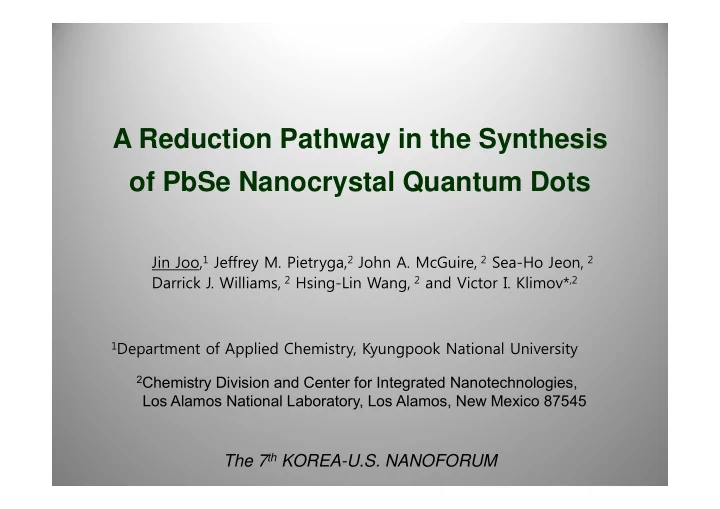

A Reduction Pathway in the Synthesis A Reduction Pathway in the Synthesis of PbSe Nanocrystal Quantum Dots y Jin Joo, 1 Jeffrey M. Pietryga, 2 John A. McGuire, 2 Sea-Ho Jeon, 2 Darrick J. Williams, 2 Hsing-Lin Wang, 2 and Victor I. Klimov* ,2 1 Department of Applied Chemistry, Kyungpook National University 2 Chemistry Division and Center for Integrated Nanotechnologies, Los Alamos National Laboratory, Los Alamos, New Mexico 87545 The 7 th KOREA-U.S. NANOFORUM
Theoretical limit of solar cells using CM � Slowered relaxation and cooling (~10X) of photogenerated hot e - and h + . ■ T ■ Traditional solar cell diti l l ll η max = 31% W. Shockley and H. J. Queisser J. Appl. Phys. 1961 , 32 , 510. ■ Carrier multiplication based solar cell p η max > 60% S S. Kolodinski, J. H. Werner, H. J. K l di ki J H W H J Queisser Solar En. Mat. & Sol. Cells 1994 , 33 , 275. 2
Why PbSe QDs ? � Band gap energy of 0.26 eV. � Larger Bohr radius of PbSe compared to other semiconductor. � PbSe 23 nm vs. CdSe 1.5 nm � 8-fold degeneracy at the lowest electronic state. � Highly efficient Carrier Multiplication (CM). � P � Preparation methods ti th d � Low production yield ~ 5%. � Efficiency of CM depends on synthesis prep. � Hard to control size (too fast growth rate). 3
Structure of NQDs solar cell Aluminum A A a-Si Si PbSe QDs ITO ITO Glass Wavelength (nm) -2 -2 -3 3 0 500 1000 1500 2000 -2.5 PbSe NQDs -4 -3 eV) -3.5 Energy (e -4 -5 + -4.5 + ITO Al -5 -6 PbSe PbSe -5.5 5 5 a-Si a-Si QDs -6 -7 -6.5 � Band edge shift was calculated from effective 4 approximation.
Reduction pathway using HDD Impurity in TOP (P(octyl) 3 ) (R a COO) 2 Pb + Se=TOP → [PbSe] + O=P(Rb) 3 + (RCO) 2 O ( ) 2 [ ] ( ) 3 ( ) 2 : Too Slow a (RaCOO) 2 Pb + PH(R c ) 2 → [Pb 0 ] + O=PH(R c ) 2 + (R a CO) 2 O : Too fast [Pb 0 ] + Se=P(R b ) 3 → [PbSe] + P(R b ) 3 J. S. Steckel et al. J. Am. Chem. Soc. 2006 , 128 , 13032. O= O= (RaCOO) 2 Pb + HDD → [Pb 0 ] +HCR + HCH + 2R a COOH (RaCOO) 2 Pb HDD [Pb ] HCR HCH 2R a COOH [Pb 0 ] + Se=P(R b ) 3 → [PbSe] + P(R b ) 3 C O OH Pb(OR) 2 OH OH C O HDD (hexadecanediol) J. Joo et al., J. Am. Chem. Soc. , 2009 , 131 , 10620. 5
Effect of HDD on PbSe synthesis Chemical Yield Growth rate Photoluminescence QY � High chemical yield up to ~ 100%. � Easy preparation bigger NQDs. � Controllable growth rate. � Narrow size distribution within 5% 6 50 nm 6
Numerical simulation procedure Generation of monomers HDD HDD [PbSe] monomer Pb(II) + Se Nucleation [PbSe] Nucl. [PbSe] monomer Repeat ~100,000 times Particle growth and dissolution Particle growth D. V. Talapin et. al. J. Phys. Chem. B , 2001 , 105 , 12279. 7 S.Kwon et. al. J. Am. Chem. Soc ., 2007 , 129 , 12571.
HDD effect on QDs growth dynamics 140 ical Yield (%) 16 Experiment 12 120 8 %) emical yield (% 100 Chemi 4 0 80 1 2 3 Radius (nm) 60 40 Che Simulation 20 0 0.0 0.5 1.0 1.5 2.0 2.5 3.0 Radius (r*) Radius (r ) 3.0 Simulation [HDD]/[Pb] = 1 [HDD]/[Pb] 0 [HDD]/[Pb] = 0 2.5 2 5 � HDD produces substantial amount of monomer 2.0 ius (r*) in nucleation step. 1.5 � Fast nucleation when HDD was used. 2.4 Rad 2.0 Radius (nm) � Sharp nucleation constructs the condition 1.0 1.6 1.2 for high chemical yield and QY. Experiment 0.5 0.8 0 100 200 300 400500 600 0 100 200 300 400500 600 Time (s) 0.0 0.0 0.5 1.0 1.5 2.0 2.5 8 Time ( τ )
Conclusions � High chemical yield and precise size control can be achieved by introducing HDD a s a reducing agent. � High quantum yield can be achieved by using HDD. � Numerical simulation exactly describes nucleation and growth mechanism of QDs. Acknowledgement Dr. Victor I. Klimov Dr. Jeff Pietryga Dr. John McGuire This work was supported by the Chemical Sciences, Biosciences, and Geosciences Division of the Office of Basic Energy Sciences, Office of Science, U.S. Department of Energy. 9
Recommend
More recommend